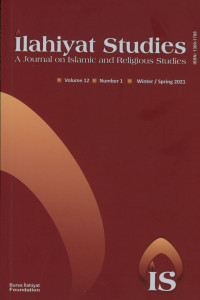A Quantitative and Stylo-Statistical Approach to the Phono-Semantic Structure of Two Companion-Prayers of the Qurʾān: al-Falaq and al-Nās
A Quantitative and Stylo-Statistical Approach to the Phono-Semantic Structure of Two Companion-Prayers of the Qurʾān: al-Falaq and al-Nās
Arabic phonosymbolism, phonological symmetry, stylostatistics, Arabic Qurʾān, iconicity functions of fricatives and plosives,
___
- al-ʿAbd, Muḥammad (1984), al-Mufāraqat al-Qurʾāniyya (Cairo: Dār al-Fikr al-ʿArabī).
- Abū Mūsā, Muḥammad (1987), Dalālāt al-tarākīb (Cairo: Maktabat Wahba).
- al-Andalusī, Abū Ḥayyān Muḥammad ibn Yūsuf al-Gharnāṭī (1983), Tafsīr al-baḥr al-muḥīṭ, 8 vols., (Beirut: Dār al-Fikr).
- Bū ʻʿUmāma, Muḥammad (2002), "al-Ṣawt wa-l-dalāla: Dirāsa fī dawʾʼ al-turāth wa-ʿilm al-lugha al-ḥadīth," Majallat al-turāth al-ʿArabī 85, 11-26.
- Crystal, David (1997), The Cambridge Encyclopedia of Language (2nd ed., Cambridge: Cambridge University Press).
- Fatani, Afnan H. (2006), "Translation and the Qurʾan," in Oliver Leaman (ed.), The Qurʾan: An Encyclopedia (London & New York: Routledge), 657-669.
- Fatani, Afnan H. (2005), "The iconic-cognitive role of fricatives and plosives: A phono-semantic analysis of a classical Arabic prayer Al-falaq," in Constantino Maeder, Olga Fischer and William J. Herlofsky (eds.), Outside-In - Inside-Out [Iconicity in Language and Literature 4] (Amsterdam: John Benjamins Publishing Company), 173-193.
- Fatani, Afnan H. (2002a), "A Diachronic Semantic Error Analysis (DSEA) of Arabic Non-core Lexicon: Chapter 114 of the Quran/An-naas ('The People')," Language Forum 28/1, 51-70.
- Fatani, Afnan H. (2002b), "The Lexical Transfer of Arabic Non-core Lexicon: Sura 113 of the Qurʾan - al-Falaq (The Splitting)," Journal of Qurʾanic Studies 4/2, 61-81.
- Fischer, Olga and Nänny, Max (2001), "Introduction: Iconicity and Nature," European Journal of English Studies 5/1, 3-16. https://doi.org/10.1076/ejes.5.1.3.4782
- Ḥassān, Tammām (1993), Al-bayān fī rawāʾiʿ al-Qurʾān (Cairo: ʿĀlam al-Kutub).
- Ibn Jinnī, Abū l-Fatḥ ʻʿUthmān al-Mawṣilī (1974), al-Khaṣāʾiṣ, 3 vols., (ed. Muḥammad ʿAlī al-Najjār; Beirut: Dār al-Hudā).
- Kenny, Anthony (1982), The Computation of Style: An Introduction to Statistics for Students of Literature and Humanities (Oxford: Per-gamon Press).
- Lyons, John (1977), Semantics, 2 vols., (Cambridge: Cambridge University Press).
- al-Rāfiʿī, Muṣṭafā Ṣādiq (1990), Iʿjāz al-Qurʾān wa-l-balāgha al-nabawiyya (Beirut: Dār al-Kitāb al-ʿArabī).
- al-Ṣaghīr, Muḥammad Ḥasan ʿAlī (2002), al-Ṣawt al-lughawī fī l-Qurʾān (Beirut: Dār al-Muʾarrikh al-ʿArabī).
- al-Zamakhsharī, Abū l-Qāsim Jār Allāh Maḥmūd ibn ʿUmar (1947), al-Kashshāf ʿan ḥaqāʿiq ghawāmiḍ al-tanzīl wa-ʿuyūn al-aqāwīl fī wujūh al-taʾwīl, 4 vols., (ed. ʿAbd al-Razzāq al-Mahdī; Beirut: Dār Iḥyāʾʼal-Turāth al-ʿArabī).
- ISSN: 1309-1786
- Başlangıç: 2010
- Yayıncı: Bursa İlahiyat Vakfı
The Problem of the Relevance of Time and Space to the Qurʾānic Text
Kumūn, İstiḥāla, and Khalq: Three Concepts in Ibn Ḥazm's Cosmology
Spiritual Purification in Islam: The Life and Works of al-Muhasibi, by Gavin Picken
The Prayer of Jawshan - A Study of Its Sources -
The Qur'an: Modern Muslim Interpretations, by Massimo Campanini
The Qur'an: Its biblical subtext, by Gabriel Said Reynolds
Teaching Islam: Islamic Religious Education in Sweden, by Jenny Berglund
